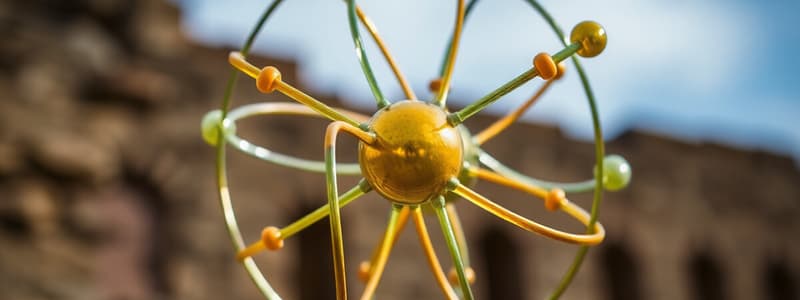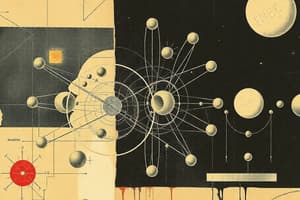Podcast
Questions and Answers
Democritus believed that atoms could be broken down into smaller particles.
Democritus believed that atoms could be broken down into smaller particles.
False (B)
John Dalton proposed that all matter is made up of very small particles called atoms.
John Dalton proposed that all matter is made up of very small particles called atoms.
True (A)
Crookes' paddle wheel experiment demonstrated that cathode rays possess insufficient energy to move a paddle wheel.
Crookes' paddle wheel experiment demonstrated that cathode rays possess insufficient energy to move a paddle wheel.
False (B)
Electrons are positively charged particles that were discovered by J.J. Thomson.
Electrons are positively charged particles that were discovered by J.J. Thomson.
Cathode rays travel in straight lines and are deflected by electric and magnetic fields.
Cathode rays travel in straight lines and are deflected by electric and magnetic fields.
The Maltese cross experiment showed that cathode rays can create a shadow when obstructed.
The Maltese cross experiment showed that cathode rays can create a shadow when obstructed.
George Stoney suggested the name 'protons' for the negatively charged particles found by J.J. Thomson.
George Stoney suggested the name 'protons' for the negatively charged particles found by J.J. Thomson.
All atoms, according to Dalton's atomic theory, are indivisible.
All atoms, according to Dalton's atomic theory, are indivisible.
Robert Millikan calculated the charge on an electron to be 1.6 x 10^19 coulombs.
Robert Millikan calculated the charge on an electron to be 1.6 x 10^19 coulombs.
The 'Plum Pudding' model of the atom was proposed by Ernest Rutherford.
The 'Plum Pudding' model of the atom was proposed by Ernest Rutherford.
Ernest Rutherford discovered the nucleus by bombarding gold foil with negatively charged beta particles.
Ernest Rutherford discovered the nucleus by bombarding gold foil with negatively charged beta particles.
James Chadwick discovered the neutron in 1932 by bombarding beryllium with alpha particles.
James Chadwick discovered the neutron in 1932 by bombarding beryllium with alpha particles.
Millikan's oil drop experiment involved oil droplets becoming positively charged.
Millikan's oil drop experiment involved oil droplets becoming positively charged.
The majority of alpha particles passed straight through the gold foil in Rutherford's experiment.
The majority of alpha particles passed straight through the gold foil in Rutherford's experiment.
The mass of an electron is calculated using a formula provided by Robert Millikan.
The mass of an electron is calculated using a formula provided by Robert Millikan.
Rutherford concluded that a small number of alpha particles collided head-on with the nucleus.
Rutherford concluded that a small number of alpha particles collided head-on with the nucleus.
Flashcards
Atom
Atom
The tiny building block of all matter.
Particulate nature of matter
Particulate nature of matter
Everything is made of very small particles, called atoms.
Cathode Rays
Cathode Rays
Streams of negatively charged particles (electrons) that travel in straight lines, can generate fluorescence in collision with materials and move a paddle wheel.
Electron
Electron
Signup and view all the flashcards
Dalton's Atomic Theory (1808)
Dalton's Atomic Theory (1808)
Signup and view all the flashcards
Democritus (400 BC)
Democritus (400 BC)
Signup and view all the flashcards
Crookes' experiment
Crookes' experiment
Signup and view all the flashcards
Thomson's experiment
Thomson's experiment
Signup and view all the flashcards
Electron charge-to-mass ratio
Electron charge-to-mass ratio
Signup and view all the flashcards
Oil drop experiment
Oil drop experiment
Signup and view all the flashcards
Electron charge
Electron charge
Signup and view all the flashcards
Rutherford's gold foil experiment
Rutherford's gold foil experiment
Signup and view all the flashcards
Nucleus
Nucleus
Signup and view all the flashcards
Alpha particle
Alpha particle
Signup and view all the flashcards
Proton
Proton
Signup and view all the flashcards
Study Notes
Atomic Structure
- Atoms are the fundamental building blocks of matter
- Democritus (400 BC) theorized that matter is composed of tiny, indivisible particles
- John Dalton (1808) proposed an atomic theory:
- Matter is composed of atoms
- Atoms are indivisible
- William Crookes (1875) experimented with cathode rays:
- Cathode rays are streams of negatively charged particles (electrons)
- Travel in straight lines
- Deflected by electric and magnetic fields
- J.J. Thomson (1897):
- Discovered electrons
- Proposed the plum pudding model of the atom (negatively charged electrons embedded in a positively charged sphere)
- Robert Millikan (1909):
- Measured the charge of an electron using the oil drop experiment
- Ernest Rutherford (1909):
- Discovered the atomic nucleus by bombarding gold foil with alpha particles
- Most atoms are mostly empty space
- Nucleus contains positively charged protons
- James Chadwick (1932):
- Discovered neutrons
- Neutrons are particles with no charge and about the same mass as protons
- Subatomic particles:
Particle Relative Charge Relative Mass Location Proton +1 1 Nucleus Neutron 0 1 Nucleus Electron -1 1/1838 Outside the Nucleus
Studying That Suits You
Use AI to generate personalized quizzes and flashcards to suit your learning preferences.
Related Documents
Description
Explore the fundamental concepts of atomic structure and the key historical figures who contributed to our understanding of atoms. From Democritus to Rutherford, this quiz covers essential theories and discoveries that shaped atomic science. Test your knowledge of atoms, electrons, and nuclear structure.



